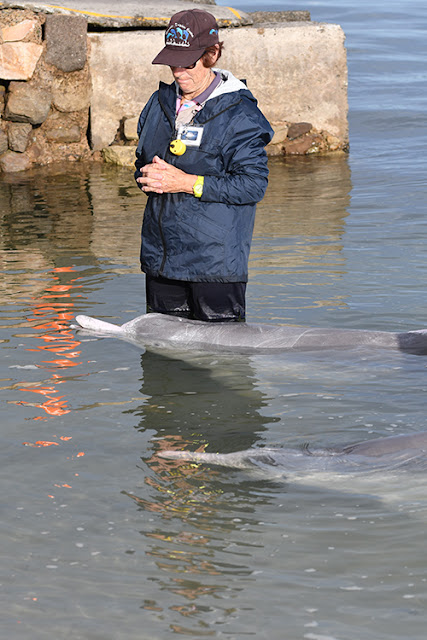1st August
An overnight stay in Tin Can Bay meant we were only minutes away from Barnacles Dolphin Centre where each morning several Australian Humpback Dolphins come in to be fed by the public. Admittedly it is a bit of a circus that I would normally shy away from, but it was a mammal tick, and wasn't quite as bad as I thought, plus the breakfast at Barnacles was very nice indeed under the very watchful gaze of some Australian Magpies and Blue-faced Honeyeaters! When we got there, two dolphins were already there waiting for their breakfast, while the two women stood in the water and explained the rules and history of the dolphin feeding at Tin Can Bay to the gathered crowd, and were joined by a mother and young calf too.
Dolphin feeding at Tin Can Bay
Blue-faced Honeyeater
Australian Magpie
After breakfast, we headed south towards the famous O'Reilly's Guesthouse in Lamington National Park, via a stop at the equally famous Yatala Pie Shop on the outskirts of Brisbane for a spot of lunch. Arriving in Canungra, the sat nav was still saying we were nearly an hour away from O'Reilly's, even though it was only 30km away, and as we started to ascend the hill, which turned into a mountain, we could soon see why as we twisted and turned up the hill, avoiding the Whiptail and Red-necked Wallabys by the roadside.
Whiptail Wallaby
After what seemed an age after a days driving, slowly driving up the mountainside, we arrived at O'Reilly's, which was much bigger than I had expected, not the simple guesthouse I had envisaged, but a resort with restaurant and cafe, gift shops and a swanky reception. Thankfully, being midweek and winter, it was quiet of people, I dread to think what it would be like in the height of summer!
2nd August
I was up and out early walking the boardwalk and some of the trails, hoping to see Albert's Lyrebird and any other local specialities. I had been warned that diversity of species may not be high, and that proved to be the case, but although I couldn't find any Lyrebirds, it was nice to get excellent views of Logrunners as they busily fed in the undergrowth, always accompanied by a scrubwren or robin after a treat they had unearthed. Other good birds on the rainforest trails included Bassian Thrush, Wonga Pigeon, a couple of confiding Green Catbirds, and several Eastern Whipbirds, which are one of the most distinctive and iconic sounds in the rainforests.
Australian Logrunner (don't ask me why they are called that!)
Eastern Whipbird
Green Catbird
Around the main resort area, the birds are very accustomed to people, especially those carrying trays of seed. King Parrots and Crimson Rosellas will happily sit on your head if you offer out food, while Satin Bowerbirds would come to within inches of you for anything dropped, not a species I was expecting to behave in such a manner. Smaller birds would mop up any dropped seed, mostly White-browed Scrubwrens, but also a group of a dozen Red-browed Finches, Superb Fairywrens and Lwin's Honeyeaters were equally confiding.
Needing a closer look at a Crimson Rosella
Australian King Parrot
Lewin's Honeyeater
Red-browed Finch
Superb Fairywren
Satin Bowerbirds (male top, female below)
3rd August
After a very comfortable night's sleep (Toni was most impressed with how comfy the mattress was, something she often complains about on our trips, even if the birding wasn't quite to her taste), we were out first thing again having read in the sightings book of Lyrebirds being seen on the Centenary Trail. Within minutes of walking down this trail, we came across an Albert's Lyrebird which was busily scraping around and although a bit skittish if you moved too quickly, was also very confiding.
Albert's Lyrebird
On the adjacent campsite, a mother and joey Red-necked Pademelon were equally confiding, we had seen them at dusk yesterday but the light was too poor for photos and so it was nice to see them both again and in better light.
Red-necked Pademelon (mum above, joey below)
Crested Shrike-tit
With the Saturday crowds staring to appear and more noisy groups on the trails, we were more than happy to pack our stuff and head back down the hill. I'm not sure if it was just the time of year, but the forest was quiet and species like Regent Bowerbird and Paradise Riflebird which I was expecting to see quite easily were both absent, but it was still a very enjoyable and relaxing couple of days
























No comments:
Post a Comment